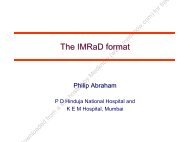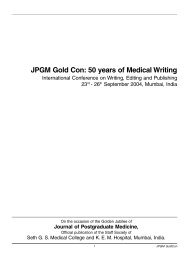Standardized reporting guidelines: The helping hands
Standardized reporting guidelines: The helping hands
Standardized reporting guidelines: The helping hands
You also want an ePaper? Increase the reach of your titles
YUMPU automatically turns print PDFs into web optimized ePapers that Google loves.
<strong>Standardized</strong><strong>reporting</strong> <strong>guidelines</strong>:<strong>The</strong> <strong>helping</strong> <strong>hands</strong>B.GitanjaliProfessorDept. of PharmacologyJIPMERPuducherry 605 006
What are they?<strong>Standardized</strong> research <strong>reporting</strong> frameworksCheck-list of items which must be referredwhen <strong>reporting</strong> a studyDifferent <strong>guidelines</strong> for different studiesSaves timeand makeslife simpler
Why were they introduced?to help ensure thatessential researchinformation, needed toassess quality, isincluded in journalarticles"inadequate <strong>reporting</strong> borders on unethical practicewhen biased results receive false credibility."Moher D, Schulz KF, Altman DG. <strong>The</strong> Lancet 2001:357;357;1191-4.
Some features…More comprehensive than the basicIMRADChecklists vary by methodology andspecific research designs.<strong>The</strong>re are several standardized formats forgeneral and specific research designsSatisfy the <strong>reporting</strong> requirements ofjournals
A few of them…CHERRIES (Checklist for Reporting Results ofInternet E-Surveys)30-item checklistfor <strong>reporting</strong> Web-based surveysJournal of Medical Internet Research (Gunther,2004). Available athttp://www.jmir.org/2004/3/e34/
A few of them…CONSORT (Consolidated Standards for ReportingTrials):a 22-item checklistfor <strong>reporting</strong> simple two group, parallel, randomizedcontrolled trials. Available athttp://www.consortstatement.org/Downloads/Checklist.docorhttp://www.consortstatement.org/Downloads/checklist.pdf
A few of them…MOOSE (Meta-Analysis Of ObservationalStudies in Epidemiology)a 35-item checklist for <strong>reporting</strong>observational studies (Stroup et al., 2000).Available athttp://www.greenjournal.org/misc/moose.pdfor http://jama.amaassn.org/cgi/content/full/283/15/2008.
A few of them…QUOROM (Quality of Reporting of Meta-Analyses)a 17-item checklist for <strong>reporting</strong> systematicreviews (Moher et al., 1999).Available at http://www.consortstatement.org/QUOROM.pdf.
A few of them…STARD (Standards for Reporting of DiagnosticAccuracy)a 25-item checklist (STARD, 2001).for diagnostic test accuracyhttp://www.clinchem.org/cgi/reprint/49/1/7.pdforhttp://www.clinchem.org/cgi/content/full/49/1/7/.
A few of them…STROBE (Strengthening the Reporting ofObservational Studies in Epidemiology)Checklist for case-control, cohort, and crosssectionalstudies (STROBE Group, 2005).http://www.strobe-statement.org
A few of them…Reporting of Observational Longitudinal ResearchA 33-item checklist patterned after CONSORT.<strong>The</strong> checklist criteria focus on threats to the internal andexternal validity of observational longitudinal studies.Additional items concern recruitment, data collection, biases,data analysis, descriptive issues and generalizability (Tooth etal., 2005).http://aje.oxfordjournals.org/cgi/content/abstract/161/3/280
A few of them…TREND (Transparent Reporting of Evaluationswith Nonrandomized Designs): a 22-itemchecklist for nonrandomized designs (DesJarlais et al., 2004).http://www.ajph.org/cgi/content/full/94/3/361/OR http://www.trendstatement.org/asp/documents/statements/AJPH_Mar2004_Trendstatement.pdf.
In addition…Qualitative Checklist(s): Several checklistsand evaluative guides have been developedfor empirical research using qualitative methodsor designs.Criteria for evaluating qualitative studies (Bromely,et al., 2002). Available athttp://www.liv.ac.uk/lstm/download/<strong>guidelines</strong>.pdf
Qualitative dataGuides for authors using research thatreports qualitative dataGreenhalgh T, Taylor R. How to read a paper: Papers thatgo beyond numbers (qualitative research). British MedicalJournal 1997;315;740-3.Patton MQ (2003).Qualitative evaluation checklist.http://www.wmich.edu/evalctr/checklists/
Instruments for specificsubspecialtiesAcupuncture (STRICTA: Standards forReporting Interventions in Controlled Trials ofAcupuncture)Acute ischemic stroke*<strong>The</strong>y include key appraisal points forassessing quality that are specific to theresearch design - intended to facilitate review*Higashidaet al.; Trial design and <strong>reporting</strong> standards forintra-arterial arterial cerebral thrombolysis for acute ischemic stroke.Stroke 2003:34(8);109-37.37.
What are the uses?ReportingDesigning the protocolReviewing papersTeaching tooluse has been associated with improved<strong>reporting</strong> quality
What are the limitations?It is only a guide, not a substitute for trainingNot instruments of evaluationFollowing them does not necessarily mean thatthe paper will be acceptedChecklists for research designed to generatequalitative data - overly prescriptive**Barbour R. Checklists for improving rigour in qualitativeresearch: A case of the tail wagging the dog? British MedicalJournal 2001;322:1115-7.
CONSORT (Con(ConsolidatedStandardsfor ReportingTrials):A 22-item checklist for <strong>reporting</strong> simple twogroup, parallel, randomized controlled trials.*Available athttp://www.consort-statement.org/Downloads/Checklist.dochttp://www.consort-statement.org/Downloads/checklist.pdf*MoherD, Schulz KF, Altman DG. <strong>The</strong> CONSORTstatement: Revised recommendations for improving thequality of reports of parallel-grouprandomised trials. <strong>The</strong>Lancet 2001:357;357;1191-4.
PAPERSECTIONAnd topicTITLE &ABSTRACTINTRODUCTIONBackgroundItem Description ReportedonPage #1 How participants were allocated tointerventions (e.g., "random allocation","randomized", or "randomly assigned").2 Scientific background and explanation ofrationale.
PAPERSECTIONAnd topicMETHODSParticipantsItem Description Reported onPage #3 Eligibility criteria for participants and thesettings and locations where the data werecollected.Interventions 4 Precise details of the interventions intended foreach group and how and when they wereactually administered.Objectives 5 Specific objectives and hypotheses.Outcomes 6 Clearly defined primary and secondaryoutcome measures and, when applicable, anymethods used to enhance the quality ofmeasurements (e.g., multiple observations,training of assessors).Sample size 7 How sample size was determined and, whenapplicable, explanation of any interim analysesand stopping rules.
PAPER SECTIONAnd topicItem Description Reported onPage #Randomization--SequencegenerationRandomization--AllocationconcealmentRandomization--Implementation8 Method used to generate the randomallocation sequence, including details of anyrestrictions (e.g., blocking, stratification)9 Method used to implement the randomallocation sequence (e.g., numberedcontainers or central telephone), clarifyingwhether the sequence was concealed untilinterventions were assigned.10 Who generated the allocation sequence,who enrolled participants, and who assignedparticipants to their groups.
PAPERSECTIONAnd topicItemDescriptionReported onPage#Blinding(masking)11 Whether or not participants, thoseadministering the interventions, and thoseassessing the outcomes were blinded togroup assignment. When relevant, how thesuccess of blinding was evaluated.Statisticalmethods12 Statistical methods used to compare groupsfor primary outcome(s); Methods foradditional analyses, such as subgroupanalyses and adjusted analyses.
RESULTSParticipant flow13 Flow of participants through each stage (adiagram is strongly recommended).Specifically, for each group report thenumbers of participants randomly assigned,receiving intended treatment, completing thestudy protocol, and analyzed for the primaryoutcome. Describe protocol deviations fromstudy as planned, together with reasons.Recruitment 14 Dates defining the periods of recruitment andfollow-up.Baseline data 15 Baseline demographic and clinicalcharacteristics of each group.Numbersanalyzed16 Number of participants (denominator) in eachgroup included in each analysis and whetherthe analysis was by "intention-to-treat".State the results in absolute numbers whenfeasible (e.g., 10/20, not 50%).
Outcomes andestimation17 For each primary and secondary outcome,a summary of results for each group, andthe estimated effect size and its precision(e.g., 95% confidence interval).Ancillaryanalyses18 Address multiplicity by <strong>reporting</strong> any otheranalyses performed, including subgroupanalyses and adjusted analyses,indicating those pre-specified and thoseexploratory.Adverseevents19 All important adverse events or sideeffects in each intervention group.
DISCUSSIONInterpretation20 Interpretation of the results, taking intoaccount study hypotheses, sources ofpotential bias or imprecision and thedangers associated with multiplicity ofanalyses and outcomes.Generalizability 21 Generalizability (external validity) of thetrial findings.Overallevidence22 General interpretation of the results inthe context of current evidence.
To conclude…• <strong>Standardized</strong> Reporting <strong>guidelines</strong> areindeed <strong>helping</strong> <strong>hands</strong> for authors• Can be used as a teaching-learning tool• Improves quality of <strong>reporting</strong>• Authors must be familiar with the<strong>guidelines</strong> specific for their area ofresearch or study design
<strong>Standardized</strong> Research Reportinghttp://researchutilization.org/sqr/standreport.html






